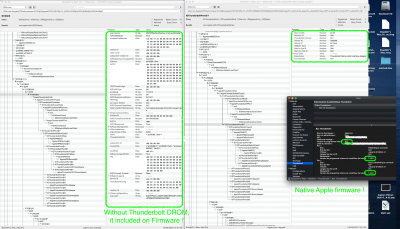CaseySJ
Moderator
- Joined
- Nov 11, 2018
- Messages
- 22,195
- Motherboard
- Asus ProArt Z690-Creator
- CPU
- i7-12700K
- Graphics
- RX 6800 XT
- Mac
- Classic Mac
- Mobile Phone
Just FYI...last night I modified TbtOnPch as follows:
- Only a simplified Ssdt TbtonPCH (without preconfiguration methods ICMS/CNHI and stay with boot register values for RP18,...NH10
- I had this 0xE00002eb error before firmware modification resulting on self disconnecting after around 20s. Now it is not prefect, i dont have 0x101 for normal results but always 0x7 with no device connected and 0x2 when connected. I suppose that is related to XHC2 not visible at boot or something else
- I will send u my current SSDT and modified firmware if you want to post it ( it include DROM from iMac19,1).. We still have to understand CRC32/CRC8 on TbtDROM to custom each firmware ( UUID and if we want the device name)
- Created method to display Link Status of all 4 ports. Why 4 ports? Because that's what latest Linux kernel does. The ports are numbered 1, 2, 3, 4.
- Connected only one TB3 device at a time.
- This SSDT sets P2TR mailbox register to 0x05.
- Hot plug does not work.
- Test 1: Connect TB device to top port.
- Result:
- Port 1: 0x02 Device Connected (top port)
- Port 2: 0x07 No device connected
- Port 3: 0x07 No device connected
- Port 4: 0x07 No device connected
- In IOReg, we see device connected to DSB1.
- Result:
- Test 2: Connect TB device to bottom port.
- Resut:
- Port 1: 0x07 No device connected
- Port 2: 0x07 No device connected
- Port 3: 0x02 Device Connected (bottom port)
- Port 4: 0x07 No device connected
- In IOReg, we see device connected to DSB1. (It still shows up under DSB1 instead of DSB4.)
- Resut:
- The first physical port gets logical port numbers 1 and 2.
- The second port gets logical port numbers 3 and 4.
- Even though the device is properly detected on the right port, it attaches only to DSB1 regardless of the physical port.
- Hotplug works.
- TNODE/TBUS do not always show up, but they will show up under some circumstances.
- Port link state is the same as before:
- Logical ports 1 and 2 belong to Physical Port 1.
- Logical ports 3 and 4 belong to Physical Port 2.
- And IOReg is correct:
- TB3 device in Port 1 --> attaches to DSB1.
- TB3 device in Port 2 --> attaches to DSB4.
Based on this, I decided to check something else:
- I switched back to P2TR = 0x05 so that TNODE/TBUS will always appear.
- After ICMS(), I reset all 4 logical ports (because Linux kernel also does this) by issuing special commands to CRMW(). The commands are:
- Disable all ports first:
- CRMW (0x37, 1, 1, 0x00004000, 0x00004000) // disable port 1
- CRMW (0x37, 2, 1, 0x00004000, 0x00004000) // disable port 2
- CRMW (0x37, 3, 1, 0x00004000, 0x00004000) // disable port 3
- CRMW (0x37, 4, 1, 0x00004000, 0x00004000) // disable port 4
- Re-enable all ports:
CRMW (0x37, 1, 1, 0x00004000, 0x00000000) // enable port 1CRMW (0x37, 2, 1, 0x00004000, 0x00000000) // enable port 2CRMW (0x37, 3, 1, 0x00004000, 0x00000000) // enable port 3CRMW (0x37, 4, 1, 0x00004000, 0x00000000) // enable port 4- CRMW (0x37, 1, 1, 0x00000000, 0x00004000) // enable port 1
- CRMW (0x37, 2, 1, 0x00000000, 0x00004000) // enable port 2
- CRMW (0x37, 3, 1, 0x00000000, 0x00004000) // enable port 3
- CRMW (0x37, 4, 1, 0x00000000, 0x00004000) // enable port 4
- Disable all ports first:
- Result:
Link State for both Receptacle 1 and Receptacle 2 in System Information --> Thunderbolt changes:From:0xe00002eb
To:0x101
- Update 14 Mar 2020: Link State remains the same after resetting ports (0xe00002eb).
- But no devices attach to the ports. Any device that was previously attached during boot gets disconnected.
- I think this is due to some (small) problem with CTBT() or NHI0.PCED().
Last edited:


